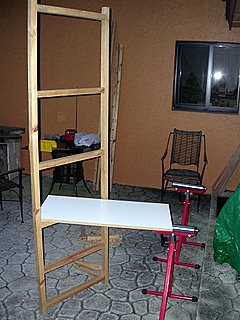I have the assembly all glued up. Now to clamp it. Normally half a dozen pipe clamps would be in order, but I don’t own a single one. (gift idea, wink wink, nudge nudge)
So for my latest rope trick, I am going to make some shelf clamps. A bowline, a truckers hitch, and tie the rope off. Simple, right?
The second cross member gets cinched tight. I tied the rope to the top, tied a loop below the not. The rope goes down and under, and back to the loop. I feed the rope through the loop, and then pull down as hard as I can at the awkward angle and trying not to get any glue on me. When doing this, the loop in the rope acts like a pulley, and you can get the rope pulled tighter. I call it a truckers hitch because I have seen old truck drivers use it to tie down loads in their pickup trucks.
I finished tying up each cross member as tight as I can make it. If you noticed, I tied 2 ropes in the same empty space, skipped a space, did 2 knots , skipped a space, did the last 2.
I came back and tied the 2 ropes in a space together as tight as I could. This really cinched the tenon and mortise joints together.
Here you can see my rope-work. Used up most of my rope doing this.
I blocked each corner and laid the bookcase frame down on the ground. I then measured for square. It is an eight of an inch off. I think I can live with that.
The top left corner was wanting to lift up off the ground. The frame isn’t laying flat. So I removed the block under that corner and weighted it down. I am hoping that when everything dries up, it will come back halfway between where it currently is, and where it wanted to be, making a nice, flat shelving support.
I spoke with my dad about my do it yourself book shelf tonight. I had decided that I am going to cut the rest of the cross members with the table saw, and wanted to ask the best way to do it. He recommended using painters caulk to fill in the gaps in my joint work so the finished, painted shelving looks really good.



